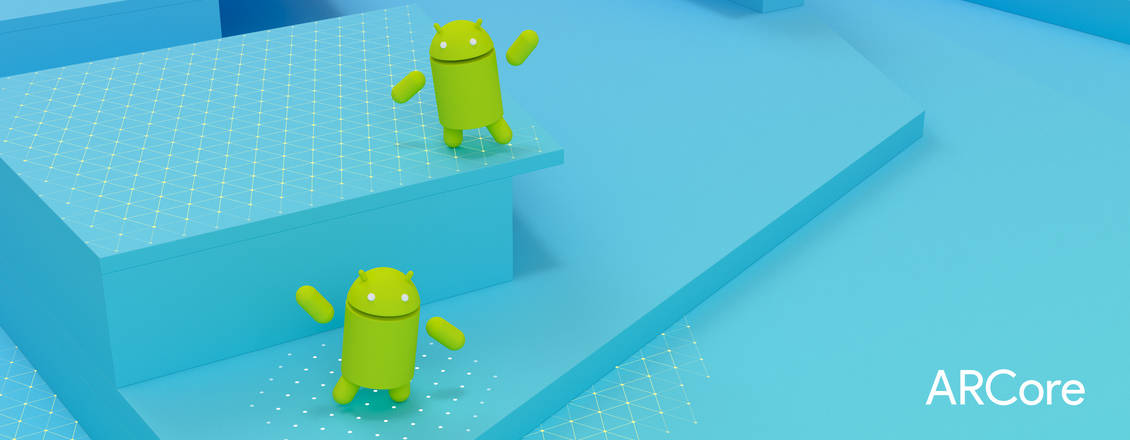
Google ARCore
What is ARCore?
ARCore is a new technology component for AR applications by Google and the counterpart of Apple’s ARKit. ARCore was announced on the 29. August 2017 by Google and shortly after made available for chosen smartphones (among others the Google Pixel and the Samsung Galaxy S8). As a AR technology element for the operating system Android, ARCore is on the same level as ARKit and therefore provides the basic components “Recognition and Placing of objects in real size” and the “creating lighting of virtual objects as real as possible”. ARCore uses the Visual Inertial Odometry (VIO) for that, which links incoming camera data with the data of Gyroscope (Position and Rotation) and the data of the acceleration sensor. Movements and orientation of the smart device can then be accurately calculated and tracking established. Size relations between reality and virtual additions can be strictly compared at the same time.
Google ARCore Publication
ARCore as part of Android
ARCore is Google’s counterpart to Apple’s ARKit and brings AR technology to the Android operating system. The release video shoes ARCore’s key features as part of creative Entertainment Apps.
Anwendungen / Demos with ARCore of different developers
Google offers its ecosystem – the developers – its own platform to present and share experiments and demos with new technologies among each other. Experiments with Google, can therefore not only be seen as a Website for ARCore demo applications but also as a melting pot and source of inspiration for AR developers. In the following, selected demos will be introduced.
ARCore Demo by Rachel Park Goto and Jane Friedhoff
AR Experiments: Hidden World
Hidden World is a simple experiment that shows hand-painted animations combined with AR functions in the environment of its user. Via a tap on the camera picture the user can create “hidden worlds” and lure little creatures out of their hiding sports.
ARCore Demo by George Michael Brower
AR Experiments: Morph Face
Morph Face is a experiment in which the user can turn surfaces of their real environment into faces. The application uses shading in order to combine the camera input and the animated 3D geometry and create the Morphing-Effect.
How does ARCore work?
ARCore basically offers similar functions as Apple’s ARKit. Core functions such as “Motion Tracking”, “Environment Understanding” and “Light Estimation” are dependent on the multi sensors of the smart devices, just as it is the case with Apple ARKit. The sensor data will then be analysed as a basis for the Virtual Interial Odometry (VIO). Incoming camera data is used together with the Gyroscope data (Position and Rotation) and the acceleration sensor data. They therefore allow the sensors to accurately analyse the movement and orientation of the smart device, which can show virtual overlapping in the context of the space and perspective on the picture. At the same time this analysis makes a clean comparison of size relations between reality and virtual additions possible. Furthermore, the virtual lighting of virtual objects will adapt to the real lighting by means of image information analysis.
Which advantages has ARCore compared to other AR Solutions?
Compared to third-party provider’s technologies (vuforia, Wikitude, etc.), Google’s ARCore is a steady part of the corresponding operating system Android and is to be used on approx. 100 million smart devices by the end of 2017. Developers receive an equivalent AR technology module to the Apple ARKit for Android (ARCore) and AR apps can therefore be realized on both big mobile operating systems. Google completes Apple’s strive to make AR functions available on all smart devices. Native apps, but also third-party provider’s apps, have now access to the native AR functions of the operating system. As a reliable and long-term provider of AR technologies, Google and its ARCore developers offer a steady basis for AR app developments.
Which disadvantages has ARCore compared to other AR Technologies?
Compared to basic AR technologies, independent from any platform, like the AR SDK vuforia, ARCore is part of Android and can therefore only be used on devices with the Android operating system (Google Pixel, Samsung Galaxy S8, etc.). If an application based on ARCore is to be realized as a cross platform and therefore able to be used on Apple’s operating system iOS, Apple’s new AR solution ARKit (get more information at ARKit in the Spotlight) could be used as a counterpart to the ARCore. Even though ARKit and ARCore, and therefore Apple and Google, strive for the same goals, it has to be tested in each case, if every function of a new AR app can be realized on both platforms.

